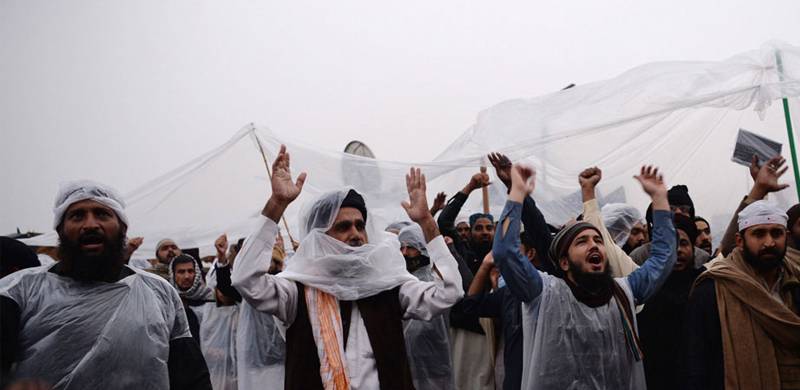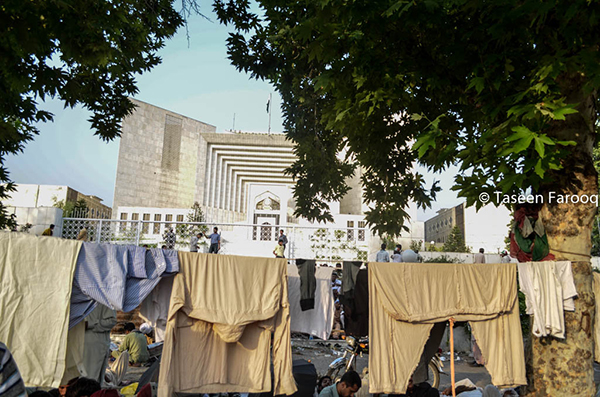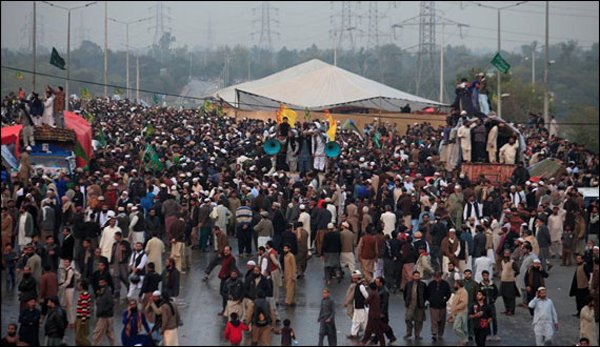
In this article, Yasser Latif Hamdani explains the Supreme Court's verdict in Faizabad dharna case.
The judgment in SMC 7/2017 i.e. Faizabad Sit-in case authored by Justice Qazi Faez Isa, is sure to go down in our history as a landmark judgment because it addresses the following points, some of which are incidental to the questions posed but must be dwelled upon.
https://www.youtube.com/watch?v=MJu7wFOC-oU
1) The scope of Article 184(3) of the Constitution of Pakistan from which the Suo Motu powers are derived. Relying on the Manzoor Elahi Case, the Benazir Bhutto Case, Sohail Butt Case and Watan Party Case, the Supreme Court has linked public importance with enforcement of fundamental right.
2) The right to life: Any protest that seeks to stop people from accessing hospitals has been declared ultra vires Article 9 of the Constitution.
3) The right of freedom of movement: Any protest that blocks roads and limits the movement of citizens has been declared ultra vires Article 15 of the Constitution.
4) The right to fair trial and due process: Any protest that stops citizens from accessing courts through blockade has been declared ultra vires Article 10-A of the Constitution.
5) The right to education: Any protest that stops citizens from gaining access to educational institutions for the purpose of learning through blockade has been declared ultra vires Article 25-A of the Constitution.
6) The right to dignity: Abuse, threats and attacks on people have been declared ultra vires Article 14(1) of the Constitution.
https://www.youtube.com/watch?v=eCNLcnOIfcQ
7) The right to livelihood: Any protest that makes businesses shut down has been declared ultra vires Article 18 of the Constitution.
8) The right to enjoyment of property: Any protest that destroys property has been declared ultra vires Article 23 of the Constitution.
9) The Judgment notes that while the Government invoked Article 245 to call in the army, the protesters were seen dispersing with men in uniform handing them money in envelopes.
10) The Judgment notes that “Inexplicably, the case was not fixed again for over five months” (Para 16). The last hearing was in April 2018 and the next hearing did not take place till after the General Elections 2018.
11) The Judgment cites two precedents for the Faizabad Dharna i.e. the 12 May 2007 massacre in Karachi and the PTI-PAT Dharna of 2014. The implication is that the government officials in 2007 were complicit in the massacre and that PTI-PAT Dharna of 2014 set another bad precedent which was used by TLP in 2017 as an example to force the hand of the government. It goes on to state in Para 23: ‘The Commission found that, “the 2013 general elections were in large part organized and conducted fairly and in accordance with the law”. The Commission’s findings were not disputed by PTI.’ In Para 24 of the Judgment, the Supreme Court states: ‘Though the findings of the Inquiry Commission had rebutted PTI’s allegations no adverse consequences followed. PTI’s leadership did not even tender an apology, let alone clean up the area or pay to clean and restore it. Instead PTI received a lot of free publicity.’ This the judgment holds became basis of TLP’s methodology. It holds that TLP was using the issue for political mileage and that intelligence agencies were unanimous on this view. It also points out that intelligence agencies reported that politicians visited the Faizabad Dharna.

12) Relying on Khan Abdul Wali Khan Judgment, the Supreme Court indicts TLP of having resorted to sedition.
13) Citing UK and Indian precedent, the Supreme Court lays down that the right to protest and demonstrate is not absolute and unqualified.
14) The question of TLP’s funding has been raised and Election Commission’s contention that the “law” is cosmetic has been derided. TLP’s hate-filled propaganda has been cited and it has been held that Channel 92 actively supported and aided TLP’s propaganda. PEMRA has been found wanting in its fulfillment of statutory duty.
15) The Judgment also takes to task PEMRA for failing to fulfill its duty in protecting the rights of legitimate license holders like Dawn and GEO and points out that Dawn, the media group founded by Mr Jinnah himself, has become the target of most egregious suppression of freedom of speech.
16) The right of freedom of speech and press has been delineated at length. Apart from quoting Mr Jinnah’s pronouncements on freedom of press, the Supreme Court relied on US Supreme Court’s Associate Justice Brandeis’ opinion in the Whitney case which has been cited by some as the greatest defence of freedom of speech. Even though the Whitney Case had upheld the conviction unanimously, Justice Brandeis’ famous opinion became the basis of US Supreme Court’s decision in Brandenburg v Ohio which over turned the Whitney judgment.
17) Intelligence Agencies have been taken to task for overstepping their mandate and going beyond what is required by law. The Court has taken a dim view of the shroud of secrecy and has cited examples from other Intelligence Agencies from around the world which are under government by law and open to public scrutiny.
https://www.youtube.com/watch?v=w993rozPf30
With these foundations, however, the directions and declarations offered by the Supreme Court are somewhat disappointing. They could have asked specifically to move against the political parties’ members who supported the Dharna.
Here are the directions issued by the Supreme Court in the judgment:
a) Direction No 1 reaffirms the right of citizens to join political parties.
b) Direction No 2 reaffirms the right of assembly and peaceful protest so long as it does not adversely impact the fundamental rights of others.
c) Direction No 3 seeks action against all protesters involved in destruction of property and blockade of roads.
d) Direction No 4 asks the Election Commission to act against any party that is in violation of the law. It is therefore clear that ECP has been directed to act against TLP.
e) Direction No 5 has made it clear that all parties have to account for their funding.
f) Direction No 6 makes impartiality and fairness on part of the state, government and independent institutions of the state mandatory.
g) Direction No 7 castigates the state for not proceeding against those at the highest echelons of government who were involved in the massacre of 12 May 2007.

h) Direction No 8 makes fatwas putting others in harm’s way or calling for harm to others unlawful and directs necessary action against all of them under relevant legislation.
i) Direction No 9 asks PEMRA to take action against broadcasters who have incited commission of offence.
j) Direction No 10 asks PEMRA to take action against Cable Operators who disrupted broadcast by licensed operators.
k) Directions No 11, 12, 13 and 14 set out the mandate for intelligence agencies and is a direction to the parliament to enact laws regulating them.
l) Direction No 15 outlaws any political activity by military personnel including meddling in political affairs in any form. It also seeks action against those who have violated their oath of loyalty to the constitution.
m) Direction No 16 asks the law enforcement agencies to formulate a proper plan dealing with public protests so that these don’t infringe upon the rights of people.
n) Direction No 17 directs federal and provincial governments to monitor those engaged in hatemongering, terrorism and extremism.
The judgment in SMC 7/2017 i.e. Faizabad Sit-in case authored by Justice Qazi Faez Isa, is sure to go down in our history as a landmark judgment because it addresses the following points, some of which are incidental to the questions posed but must be dwelled upon.
https://www.youtube.com/watch?v=MJu7wFOC-oU
1) The scope of Article 184(3) of the Constitution of Pakistan from which the Suo Motu powers are derived. Relying on the Manzoor Elahi Case, the Benazir Bhutto Case, Sohail Butt Case and Watan Party Case, the Supreme Court has linked public importance with enforcement of fundamental right.
2) The right to life: Any protest that seeks to stop people from accessing hospitals has been declared ultra vires Article 9 of the Constitution.
3) The right of freedom of movement: Any protest that blocks roads and limits the movement of citizens has been declared ultra vires Article 15 of the Constitution.
4) The right to fair trial and due process: Any protest that stops citizens from accessing courts through blockade has been declared ultra vires Article 10-A of the Constitution.
5) The right to education: Any protest that stops citizens from gaining access to educational institutions for the purpose of learning through blockade has been declared ultra vires Article 25-A of the Constitution.
PTI’s leadership did not even tender an apology, let alone clean up the area or pay to clean and restore it. Instead PTI received a lot of free publicity.’ This the judgment holds became basis of TLP’s methodology. It holds that TLP was using the issue for political mileage and that intelligence agencies were unanimous on this view. It also points out that intelligence agencies reported that politicians visited the Faizabad Dharna.
6) The right to dignity: Abuse, threats and attacks on people have been declared ultra vires Article 14(1) of the Constitution.
https://www.youtube.com/watch?v=eCNLcnOIfcQ
7) The right to livelihood: Any protest that makes businesses shut down has been declared ultra vires Article 18 of the Constitution.
8) The right to enjoyment of property: Any protest that destroys property has been declared ultra vires Article 23 of the Constitution.
9) The Judgment notes that while the Government invoked Article 245 to call in the army, the protesters were seen dispersing with men in uniform handing them money in envelopes.
10) The Judgment notes that “Inexplicably, the case was not fixed again for over five months” (Para 16). The last hearing was in April 2018 and the next hearing did not take place till after the General Elections 2018.
11) The Judgment cites two precedents for the Faizabad Dharna i.e. the 12 May 2007 massacre in Karachi and the PTI-PAT Dharna of 2014. The implication is that the government officials in 2007 were complicit in the massacre and that PTI-PAT Dharna of 2014 set another bad precedent which was used by TLP in 2017 as an example to force the hand of the government. It goes on to state in Para 23: ‘The Commission found that, “the 2013 general elections were in large part organized and conducted fairly and in accordance with the law”. The Commission’s findings were not disputed by PTI.’ In Para 24 of the Judgment, the Supreme Court states: ‘Though the findings of the Inquiry Commission had rebutted PTI’s allegations no adverse consequences followed. PTI’s leadership did not even tender an apology, let alone clean up the area or pay to clean and restore it. Instead PTI received a lot of free publicity.’ This the judgment holds became basis of TLP’s methodology. It holds that TLP was using the issue for political mileage and that intelligence agencies were unanimous on this view. It also points out that intelligence agencies reported that politicians visited the Faizabad Dharna.

12) Relying on Khan Abdul Wali Khan Judgment, the Supreme Court indicts TLP of having resorted to sedition.
13) Citing UK and Indian precedent, the Supreme Court lays down that the right to protest and demonstrate is not absolute and unqualified.
The Judgment also takes to task PEMRA for failing to fulfill its duty in protecting the rights of legitimate license holders like Dawn and GEO and points out that Dawn, the media group founded by Mr Jinnah himself, has become the target of most egregious suppression of freedom of speech.
14) The question of TLP’s funding has been raised and Election Commission’s contention that the “law” is cosmetic has been derided. TLP’s hate-filled propaganda has been cited and it has been held that Channel 92 actively supported and aided TLP’s propaganda. PEMRA has been found wanting in its fulfillment of statutory duty.
15) The Judgment also takes to task PEMRA for failing to fulfill its duty in protecting the rights of legitimate license holders like Dawn and GEO and points out that Dawn, the media group founded by Mr Jinnah himself, has become the target of most egregious suppression of freedom of speech.
16) The right of freedom of speech and press has been delineated at length. Apart from quoting Mr Jinnah’s pronouncements on freedom of press, the Supreme Court relied on US Supreme Court’s Associate Justice Brandeis’ opinion in the Whitney case which has been cited by some as the greatest defence of freedom of speech. Even though the Whitney Case had upheld the conviction unanimously, Justice Brandeis’ famous opinion became the basis of US Supreme Court’s decision in Brandenburg v Ohio which over turned the Whitney judgment.
17) Intelligence Agencies have been taken to task for overstepping their mandate and going beyond what is required by law. The Court has taken a dim view of the shroud of secrecy and has cited examples from other Intelligence Agencies from around the world which are under government by law and open to public scrutiny.
https://www.youtube.com/watch?v=w993rozPf30
With these foundations, however, the directions and declarations offered by the Supreme Court are somewhat disappointing. They could have asked specifically to move against the political parties’ members who supported the Dharna.
Here are the directions issued by the Supreme Court in the judgment:
a) Direction No 1 reaffirms the right of citizens to join political parties.
b) Direction No 2 reaffirms the right of assembly and peaceful protest so long as it does not adversely impact the fundamental rights of others.
c) Direction No 3 seeks action against all protesters involved in destruction of property and blockade of roads.
d) Direction No 4 asks the Election Commission to act against any party that is in violation of the law. It is therefore clear that ECP has been directed to act against TLP.
e) Direction No 5 has made it clear that all parties have to account for their funding.
f) Direction No 6 makes impartiality and fairness on part of the state, government and independent institutions of the state mandatory.
g) Direction No 7 castigates the state for not proceeding against those at the highest echelons of government who were involved in the massacre of 12 May 2007.

h) Direction No 8 makes fatwas putting others in harm’s way or calling for harm to others unlawful and directs necessary action against all of them under relevant legislation.
i) Direction No 9 asks PEMRA to take action against broadcasters who have incited commission of offence.
j) Direction No 10 asks PEMRA to take action against Cable Operators who disrupted broadcast by licensed operators.
k) Directions No 11, 12, 13 and 14 set out the mandate for intelligence agencies and is a direction to the parliament to enact laws regulating them.
l) Direction No 15 outlaws any political activity by military personnel including meddling in political affairs in any form. It also seeks action against those who have violated their oath of loyalty to the constitution.
m) Direction No 16 asks the law enforcement agencies to formulate a proper plan dealing with public protests so that these don’t infringe upon the rights of people.
n) Direction No 17 directs federal and provincial governments to monitor those engaged in hatemongering, terrorism and extremism.
